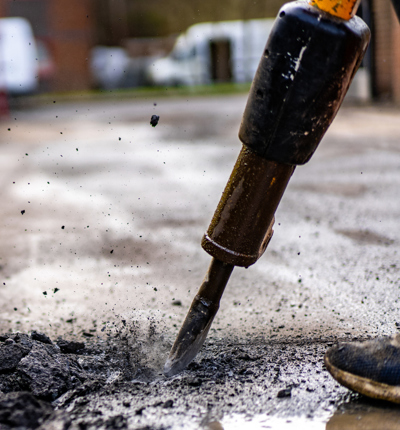
Hand arm vibration claims
If you suffer the effects of Hand Arm Vibration Syndrome (HAVS) from work, contact us to make a claim today
Hand Arm Vibration Syndrome (HAVS), formerly known as Vibration White Finger (VWF), is caused by the prolonged use of vibrating machinery and hand-held power tools, including:
- power drills
- hammer drills and pneumatic drills
- sanders
- chainsaws
- road breakers
- powered lawnmowers.
HAVS can cause severe pain and long-term damage to a person’s fingers and hands, making their daily lives difficult.
Our workplace injury team has represented many people who have suffered the effects of HAVS. Talk to us as soon as possible to investigate a claim.
What our clients say
I thank God that Leigh Day was in charge of handling my case. I want to specifically thank Ross Whalley and his team for handling my case with the up most care and professionalism from start to finish.
Mr L Pierre, via Trustpilot
What our clients say
What are hand arm vibration claims?
Hand Arm Vibration Syndrome can lead to significant poor health. It can cause painful and disabling disorders affecting the hand and forearm, including:
- blood vessels
- nerves
- muscles and joints
- connective tissues.
Some 2 million people are at risk of HAVS in the UK. While it is preventable, once the damage has occurred, it is permanent. People who have developed this syndrome are often unable to work in their previous role.
Symptoms of HAVS, which is often triggered by cold weather, include:
- tingling ‘whiteness’ or numbness in the fingers
- fingers changing colour
- the loss of manual dexterity
- the loss of strength and grip in the hands
- in rare cases the sufferer may lose fingers.
Your employer’s responsibility
Employers have a duty of care to protect their workers from harm by keeping the workplace compliant and safe.
If they do not follow the relevant health and safety regulations and you suffer an injury or workplace accident as a result, you may be able to make a claim.
The Control of Vibration at Work Regulations 2005
This informs employers of the steps they must take to ensure that their employees are protected from developing HAVS, including:
- Control measures to reduce exposure to vibrations
- Risk assessment and management
- Training, information and health surveillance
- Advice for employers and employees.
The Health and Safety at Work Act 1974
The Health and Safety at Work Act is the main legislation that aims to protect the health, safety and welfare of employees in the workplace.
These regulations ensure that all employers provide a safe and functional working environment, including:
- Well-maintained equipment
- A health and safety policy
- Risk assessments
- Appropriate training and information
Download our personal injury brochure
Download a copy of our personal injury brochure to learn more about how we can help you and how we have helped others following a serious injury
What to do if you are injured at work
Leigh Day’s team of expert lawyers can offer you guidance and support if you suffer an injury at work.
Above all, your health is the top priority. The first thing you must do is seek medical treatment for your injury.
If you need to visit the hospital, make sure that an accurate account of the incident is given to the first doctor who treats you.
Even if you don't require hospital treatment, always contact your GP as soon as possible. They will need an accurate report of the accident too.
Your medical records will be requested during the course of your injury claim.
Contact our team as soon as you can. From the day your accident occurred, you have three years to begin Court proceedings.
Report your workplace incident as soon as you can and secure a copy of the accident book entry from your employers. This will be used as important evidence for your claim.
Health and Safety Executive (HSE) may decide that the seriousness of the injury sustained warrants an investigation.
Other than a brief report for the accident book, there is no need to make a statement to your employers about your incident.
Generally, it is best to avoid signing a statement, especially straight after your incident.
Make sure to report what happened to the Department for Work and Pensions. It can help you make a state benefit application.
Collect details of any witnesses to your incident and give this information to our team as soon as possible.
Contact your shop steward or safety representative for approval to take photos of the scene of the incident.
Be sure to take photographs of your injuries as soon as you can after the incident, and regularly during your recovery.
Our work with HAVS
He first noticed symptoms of HAVS when he was on holiday. After he had been swimming, his fingers appeared notably white. Soon after, he saw an Occupational Health specialist who diagnosed him with HAVS.
His employer admitted legal responsibility for exposing him to excessive vibration in the course of his work, but disputed that the vibrations had caused his symptoms.
A former employer refused to admit that the man had ever worked for them but, if he had, they denied that there was any excessive vibration. They also disputed that the vibrations had caused his symptoms.
The Leigh Day workplace injury team investigated the case, gathering evidence from a Vascular Surgeon who confirmed the man had HAVS and it was caused by his workplace exposure. Civil proceedings were issued against both the employers.
A couple of months before the trial, both employers offered the man a five-figure settlement proposal which he accepted. Our client still works for his second employer, but in a different role which involves no exposure to vibrating tools.
Hand arm vibration FAQs
Yes. Your employer is responsible for your health and welfare in the workplace. If they have failed to protect you from developing HAVS, you may be able to secure compensation by making a claim.
Every workplace injury is different. Our team will need as much information about your HAVS injury as possible to calculate your compensation. This may include:
- How the injury has impacted your life
- Physical and psychological damage
- Any medical treatments required
- Time taken off work
- Any significant changes that needed to be made to your home.
Most workplace injury claims run on a ‘no win no fee agreement’. This means that if your case is unsuccessful, you will not pay any legal fees. If your case is successful, the majority of your costs will be paid by your opponent.
Contact us as soon as possible to investigate a claim.

